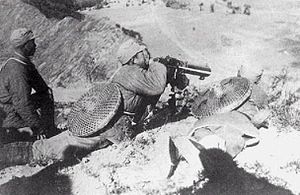The Battle of Pingxingguan (Chinese: 平型关战役; pinyin: Píngxíng Guān Zhànyì), also commonly called the "Great Victory of Pingxingguan" (Chinese: 平型关大捷; pinyin: Píngxíng Guān Dàjié) in Mainland China, was an engagement fought between the 8th Route Army of the Communist Party of China and the Imperial Japanese Army on September 25, 1937.[2]
It resulted in a minor, morale-boosting victory for the Chinese Communists[2] with an otherwise insignificant number of casualties and a small amount of captured supplies.
Background[]
After the capture of Beiping (present Beijing) at the end of July, Japanese forces advanced along the Beiping-Suiyuan railway line to Inner Mongolia. Having anticipated the move, Chiang Kai-shek had appointed the Shanxi warlord Yan Xishan as Pacification Director of Taiyuan. Theoretically Yan had authority over all the Chinese military forces in his theatre of operations, including Lin Biao's 115th Division of the Communist 8th Route Army, Liu Ruming's ex-Kuomintang troops and various Central Army contingents responsible to Chiang Kai-shek. In reality these forces operated independently from Yan's provincial army.
Japanese forces, mainly the 5th Division and 11th Independent Mixed Brigade, moved out from Beiping and advanced on Huailai County in Chahar. A Japanese column advanced quickly into Shanxi, making use of the railway which the Chinese did not attempt to destroy. The Chinese abandoned Datong on September 13, falling back to a line from Yanmenguan on the Great Wall east to the mountain pass of Pingxingguan. Yan Xishan's troops became more demoralised as the Japanese exerted their air supremacy.
The main body of the Japanese 5th Division, under the command of Itagaki Seishiro,[2] advanced from Huaili to invade northeastern Shanxi. Although it had a motorised transport column, its rate of advance was limited by the poor roads. By the time they reached the Shanxi border, Lin Biao's 115th Division, after a forced march from Shaanxi, was in place at Pingxingguan on September 24 to ambush the Japanese army.
Order of Battle Battle of Pingxingguan
The battle[]
The pass of Pingxingguan was a narrow defile worn through the loess, with no exit for several kilometres except the road itself. Lin's division were able to ambush two columns of mainly transportation and supply units and virtually annihilate the trapped Japanese forces.
On September 25, the 21st brigade of the Japanese 5th Division stationed at LingQiu received a request from the 21st Regiment that they urgently needed supplies due to falling temperature. The supply troops of the 21st Regiment set out with 70 horse-drawn vehicles with 50 horses, filled with clothes, food, ammunition and proceeded westwards towards Pingxingguan. Around 10:00, the supply column passed into a defile with the two sides rising up more than 10 meters; they were heading towards Cai Jia Yu about 3 km away.
At the same time, a motorized column of Japanese supply troops in about 80 trucks left Guan Gou and headed east. Both of these non-combat formations entered into the ambush set by the 115th division after 10 a.m. on the 25th and were largely wiped out. A relief force consisting of the 3rd Battalion of the 21st Regiment was rebuffed by Chinese troops and suffered almost 100 casualties. Lin Biao's troops eventually withdrew from the battlefield, allowing the Japanese to finally reach the site of the ambush on September 28.
The total, the Japanese casualties in the battle have been estimated at 400 to 500 and the Chinese at about 400.[1] The Chinese forces destroyed about 70 trucks and an equal number of horse-drawn carts and captured 100 rifles, 10 light machine guns, 1 gun, 2000 shells as well as some clothing and food.[1]
Evaluation[]

Memorial Hall of the battle
The Kuomintang official history of the Second Sino-Japanese War deals with it in a sentence, without any credit to the communists. Communist accounts, on the other hand, describe Pingxingguan as a typical example of Red guerrilla tactics, inspired by Mao Zedong's conceptualization of People's war. Japanese losses were greatly exaggerated for propaganda purposes. However, like the victory at the Battle of Taierzhuang, Pingxingguan was explained by Japan as Japanese officers succumbing to what they came to call "victory disease".[3]
After a series of easy victories against their opponents, they failed to take elementary precautions. Japanese commanders seldom repeated the operational blunders that had led to Pingxingguan. Nonetheless, the battle gave the Chinese a major boost in morale and credence to the Communists in the eyes of the people. The battle was constantly cited by CPC brass as an example of their commitment to battling the Japanese occupation.[3]
References[]
- ↑ 1.0 1.1 1.2 1.3 Yang Kuisong, "On the reconstruction of the facts of the Battle of Pingxingguan"
- ↑ 2.0 2.1 2.2 Spencer C. Tucker, A Global Chronology of Conflict: From the Ancient World to the Modern Middle East: From the Ancient World to the Modern Middle East, ABC-CLIO, Dec 23, 2009
- ↑ 3.0 3.1 Mao: The Unknown Story by Jung Chang and Jon Halliday, p. 279
External links[]
- Mao Tsetung: The Art of War,The Battle of Pinghshingkuan Pass
- Description (in Chinese) of the Battle of Pingxingguan in the on line version of the book: 中国抗日战争正面战场作战记 (China's Anti-Japanese War Combat Operations) by 郭汝瑰 (Guo Rugui), Jiangsu People's Publishing House, 2005-7-1, ISBN 7-214-03034-9
- a more recent study (in Chinese) 关于平型关战斗的史实重建问题 "On the reconstruction of the facts of the Battle of Pingxingguan" by Professor Yang Kui Song
- Pingxingguan Campaign
- 抗战烽火:平型关大捷 (Sino-Japanese War beacon-fire: Pingxingguan victory) Map and photos of the battle, in Chinese
- China AMS Topographic Map of Pingxingguan battle area from Perry-Castañeda Library Map Collection (area near GP5,6)
| Wikimedia Commons has media related to Battle of Pingxingguan. |
The original article can be found at Battle of Pingxingguan and the edit history here.
